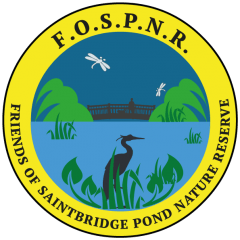The Saintbridge Pond and Nature Reserve is in full Spring Bloom
It’s always nice to have a stroll around the pond looking for new things. I was lucky enough to see my first Moorhen nest last week (mid-April 2022), I could not believe the intricacy of the build, I have read that the nest (tower) can be built with some serious teamwork in as little as 12 hours !. Please see the gallery below (thanks to Pete Wilson for the pictures of the nest and the amazing photo of one of the parents sitting with the baby chicks)
So anyway, I popped by yesterday and saw the nest empty. I was able to see the parents, but my stomach sank in worry that the chicks had fallen prey to the same fate as all the ducklings last week (I spotted a seagull eating one last week). After spending a lot of time trying to spot the chicks I was excited when one was spotted by a passerby coming in and out of a hiding place in the rushes next to the bank. I quickly grabbed my camera and fired off a couple of pictures (not great quality but in one of the pics you can see the chick ready for food delivery from mum).
Moorhen Facts
(source)
What type of animal is a moorhen?
The common moorhen species is a species of a medium-sized water bird, also referred to as the Eurasian moorhen and sometimes described as a ‘swamp chicken’. They belong to the rail family and are a close relative to coots. The common moorhen (Gallinula chloropus) belongs to the phylum Chordata and Gallinule genus.
What class of animal does a moorhen belong to?
The moorhen species is a species of medium-sized water birds belonging to the class Aves. The common moorhen (Gallinula chloropus) is also known as the common gallinule.
How many moorhens are there in the world?
There are a total of 10 common moorhen species found all over the world. The exact number of common moorhen (Gallinula chloropus) in total is not known.
Where does a moorhen live?
Although moorhens are found all around the world, there are a few regions where they are found in abundance. The good vegetation of marshes, as well as ponds, streams, and river mouths, attract them the most. A few common moorhen species can also be found in the lowland areas of central as well as eastern England.
What is a moorhen’s habitat?
The common moorhen species’ habitat ranges from farmland to grassland and wetlands. Since they require water bodies (being aquatic animals) for their survival, for nesting, and in order to escape from their enemies, they can normally be spotted either swimming without any fear or hiding in the weeds on the banks of water bodies. Most of them migrate to the safest areas right before their breeding season in order to build their nests closer to riverbanks, in order to attain a good and safe shelter for their infants.
Who do moorhens live with?
The common moorhen species tend to live in groups called flocks, the density of which varies. They can either be large groups or simply just a group of a few birds sticking around. Particularly in the breeding season, these birds choose to stay close to their group. Some people claim that moorhens are easy to spot, but they are quite shy animals so they try to avoid any form of human interaction whenever possible.
How long does a moorhen live?
18 – 19 years is the lifespan of the average common moorhen population (Gallinula chloropus).
How do they reproduce?
The process of mating and breeding this bird begins in spring (approximately from mid-March). The first move is made by the adult male bird who moves closer to the female moorhen with his beak dipped inside the water. If the adult female bird accepts this mating proposal then they go on nibbling on each other’s feathers before actually starting to work together in order to build a nest. They try their level best to build their nest at the best possible spot, where it will be safe from other birds. The protection of the nest and the eggs inside the nest is a priority for these birds. (see pictures above)
After the nesting is done the adult female moorhen lays between seven to eight eggs and the male and female take turns incubating them until the eggs hatch (after approximately three weeks). From the time when the egg hatches, until when the babies are grown up enough to fly away, both the male and female moorhen take responsibility for feeding and protecting their young. If the moorhens are in a location of high threat, the babies are known to stick to their parents while they take them to a safer area. Once the babies grow up (which usually takes almost a year), they fly off and start a family of their own, where the whole life cycle repeats itself all over again. The lifespan of moorhens is not known to be very long, most moorhens usually live for a maximum of three years, but the oldest moorhen on record was known to be almost 10 years old at the time he was recaptured!
What is their conservation status?
Common. Classified in the UK as Amber under the Birds of Conservation Concern 5: the Red List for Birds (2021). Protected in the UK under the Wildlife and Countryside Act, 1981. (source)


Moorhen Fun Facts
What do moorhens look like?
Moorhens are blessed with a bright red beak which works as a shield for them by extending itself to its very black eyebrows.
Moorhens are wrapped in charcoal black and grey feathers with brown wings. Their wings are decorated with white stripes as well as small white dots. Their legs highly compliment the white body colour of the moorhens, as they are a bright yellow colour, with no webbing. The bright red beak with a pointed yellow tip adds to this bird’s overall beauty.
How cute are they?
Moorhens’ beautiful glowing eyes and beautiful bright white-coloured beaks make them look super adorable. The beautiful white textured fur makes them look super soft too.
How do they communicate?
The female is known to make a murmur call when she is ready to mate.
How big is a moorhen?
A medium-sized to large-sized moorhen ranges from 12-15 in (30-38 cm) in length with a span of about 20-24 in (51-61 cm) across the wings. The bodyweight of a moorhen ranges from 12-19 oz (340-540 g). It is five times smaller than a big dog.
How high can a moorhen fly?
Although common moorhen can fly, they aren’t very good at it so they only cover short distances. Newborn moorhens learn to take a flight at seven weeks old, however, they stick around with their family until autumn. After that, they wander off and are later known to take refuge on trees as high as 20 ft (6 m) or more.
How much does a moorhen weigh?
The average body weight of a common moorhen ranges from 12-19 oz (340-540 g) and they have a wingspan of 20-24 in (51-61 cm).
What are the male and female names of the species?
Although there’s no particular name for each gender, one common trick used to tell the difference between male and female moorhens is the fact that male moorhens are usually a little bigger than females.
What would you call a baby moorhen?
Moorhens are also called Gallinula Comeri, and baby moorhens in particular are known as moorhen chicks.
What do they eat?
Moorhen, as mentioned above, are omnivores therefore they can be found eating both plants and animal matter (insects). Their diet includes various aquatic creatures like fishes, frogs, and snails along with insects, worms, and eggs.
Other facts
Although moorhens belong to the bird family, they are not very good at flight. They are only able to take flights of short distances, be it upright or horizontally.
It may seem shocking, but moorhens don’t hesitate before eating their fellow mates’ eggs if given a chance. They tend to eat other moorhen’s eggs and believe that by doing so, they are protecting their own.
Moorhens normally have either two or three broods of baby moorhens. Interestingly, adult moorhens from the previous hatching are known to help their parents with taking care of their new babies in the next breeding season.
What are some nicknames for moorhens?
Moorhens are sometimes also called marsh hens.
Are moorhen aggressive?
The common gallinule is noted to be highly aggressive during their nesting season in order to protect both their infants and their shelters. Females are also known to be quite aggressive while fighting for a mate (this kind of behaviour is usually seen during the mating season at the start of April.) Although the common moorhen is known for carefully taking care of its infants right after their birth, it is also known for aggressively sending them off as soon as they show signs of adult bird plumage.



 If, like me, you’ve been wandering around the pond and looking and the burst of colour which has greeted us, you probably feel a sense of calm and the ability just to be in the now.
If, like me, you’ve been wandering around the pond and looking and the burst of colour which has greeted us, you probably feel a sense of calm and the ability just to be in the now. 




 The first quote in the book is the following :
The first quote in the book is the following :












 Red Kite
Red Kite



























 Breeding
Breeding